
Over the past few weeks, I've been posting a blog each week about social networking themes in the build up to the big bank tradeshow, SIBOS.
First, I argued that banks don't innovate, and then I put forward the reasons why social networks are relevant to banks.
Nevertheless, although I regularly blog about social networks
and disruptive innovation in banking, the fact is that traditional
banks are surviving and thriving whilst new businesses struggle to gain
market share.
In fact, most new businesses in banking hardly make any impact at all.
Why is this?
Think about ten years ago.
I bet that, ten years ago, the top four banks in your country are the same top four as today.
Why is this?
It certainly is not down to competition or market forces as, if it were, the list would be completely different.
In music, retail, airlines or most other industries, the list is wildly different thanks to the impact of the internet and new competitors with new business models.
Why isn't banking being impacted in the same way?
I’ve blogged about the impact of the net many times and its likely outcome on banking, and the core message is that ten years ago any business involved in promotion and communication and marketing would have 80% of their spend wrapped up in print and post.
With 80% of the cost taken out of the business, why aren't we seeing the cost savings in banking?
Take my own business of organising a Club.
The Club has a database of over 10,000 people who we mail about once a week on average. We also have over 1,000 people who subscribe to the blog through various means who we mail once a day.
Our online brochure would have been produced as a nice glossy handout with a print run of around 10,000, and our mailout costs for club news, daily updates and marketing would have been around £3,000 a week.
This is the point I’m making in this presentation on slides 4 and 5.
After a decade of disruptive technologies, where are the disruptions in banking?
Ten years ago, to run my business would have cost around a million dollars a year, 80% of which was tied up in marketing, communications, promotion, print and postage.
Today, all of that cost has gone.
All of the marketing, communication, distribution and promotion is free.
There are no print or postal costs, because all of it can be performed through a simple internet connection.
With zero print and post overhead, where are the cost savings in banking?
Today, for $30 a month, anyone can link to a broadband feed and connect to the planet.
The result is that the 10,000 emails are free to send out electronically as often as you wish, compared to the costs of the 10,000 stamps and envelopes a decade ago.
The 10,000 pdf’s, which replace the 10,000 brochures, are free to offer as an electronic download.
And the 1,000 emails per day for the newsletter are sent out automatically from the blog’s website, with no human costs involved.
The only costs left are those of people and physical space. The costs in my business are just the costs of having meetings. Human networking in real life versus another life.
As you remove fixed costs, the net effect is that what used to cost $1 million a year to run a networking group is reduced to $100,000 as 90% of costs are removed through electronic connections. All the cost overheads of the business – the postage and print distribution – has gone.
With zero fixed costs, what could the bank of tomorrow look like?
You can take this a lot further. For example, ten years ago, the cost of a typical advertisement on a mainstream TV channel would be $50,000 for a 30–second spot at prime time. The cost of making the ad? For a decent production, let’s set a budget of a million.
Therefore, to run a new ad campaign using traditional media would be around $5 million or more.
Roll forward ten years and how would you do this today?
Ask your customers to make the ad.
There are many examples of such campaigns, including the Wells Fargo Rosebowl campaign and the Barclaycard Waterslide.
Customers make the ads and post them on YouTube and you offer a prize to the best production of $10,000.
Costs of this campaign?
$10,000 plus the internal staff costs of promoting via email.
From $5 million to $10,000 for a marketing campaign; and from $1 million to $100,000 for running business.
With zero marketing, distribution and communication costs, where is the bank of tomorrow?
So here’s my question.
If 80% or more of the costs of a business that were wrapped up in print and postage, marketing and communication, have gone away ... why haven’t we seen a related reduction in pricing and fees?
Think back ten years to banking in 1999, and the fees and charges haven’t changed a great deal. Equally the competitive landscape has not changed a great deal.
Sure there are new business models emerging – the Zopa, SmartyPig, PayPal and more – but real disruptions in banking are nonexistent.
Why?
Simple answer?
Regulatory protectionism.
There has been no disruption in banking because the costs of entry, access to banking licences, requirements for capital reserves, mandates for management, ability to gain regulatory approvals and the opportunity to change the business model are so prohibitively expensive and time consuming that it just ain’t worth it.
Now there’s a discussion.
Chris M Skinner
Chris Skinner is best known as an independent commentator on the financial markets through his blog, TheFinanser.com, as author of the bestselling book Digital Bank, and Chair of the European networking forum the Financial Services Club. He has been voted one of the most influential people in banking by The Financial Brand (as well as one of the best blogs), a FinTech Titan (Next Bank), one of the Fintech Leaders you need to follow (City AM, Deluxe and Jax Finance), as well as one of the Top 40 most influential people in financial technology by the Wall Street Journal's Financial News. To learn more click here...























